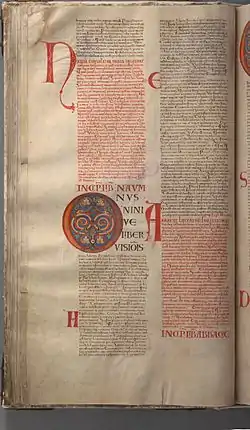Nahum 3
Nahum 3 is the third and last chapter of the Book of Nahum in the Hebrew Bible or the Old Testament of the Christian Bible.[1][2] This book contains the prophecies attributed to the prophet Nahum, and is a part of the Book of the Twelve Minor Prophets.[3][4] This chapter describes the cause of the destruction of Nineveh.[5]
| Nahum 3 | |
|---|---|
 | |
| Book | Book of Nahum |
| Category | Nevi'im |
| Christian Bible part | Old Testament |
| Order in the Christian part | 34 |
Text
The original text was written in Hebrew language. This chapter is divided into 19 verses.
Textual witnesses
Some early manuscripts containing the text of this chapter in Hebrew are of the Masoretic Text, which includes the Codex Cairensis (895), Aleppo Codex (10th century), Codex Leningradensis (1008).[6]
Fragments cumulatively containing all verses of this chapter were found among the Dead Sea Scrolls, including 4QpNah, known as the "Nahum Commentary" (1st century BCE) with extant verses 1-5, 6-9, 10-12, 14;[7][8] 4Q82 (4QXIIg; 1st century BCE) with extant verses 1‑3, 17.[9][10][11] and Wadi Murabba'at MurXII with extant verses 1‑19.[9][12]
There is also a translation into Koine Greek known as the Septuagint, made in the last few centuries BC. Extant ancient manuscripts of the Septuagint version include Codex Vaticanus (B; B; 4th century), Codex Sinaiticus (S; BHK: S; 4th century), Codex Alexandrinus (A; A; 5th century) and Codex Marchalianus (Q; Q; 6th century).[13] Some fragments containing parts of this chapter (a revision of the Septuagint) were found among the Dead Sea Scrolls, i.e., Naḥal Ḥever (8ḤevXIIgr; 1st century CE) with extant: verses 3, 6‑17.[9][14]

Structure
NKJV groups this chapter:
- Nahum 3:1-7 = IV. The Cause of the Destruction: The woe of Niniveh
- Nahum 3:8-15 = Comparison to other lands
- Nahum 3:16-19 = The final judgment
Verse 8
- Are you better than No Amon
- That was situated by the River,
- That had the waters around her,
- Whose rampart was the sea,
- Whose wall was the sea?[15]
- "No Amon" is translated from Hebrew word: נא אמון nō-’ā-mō-wn,[16] (Jeremiah 46:25; Ezekiel 30:15-16)[5] that is ancient Thebes,[17] referring to the Egyptian name Niwt-Imn, the "City of Amun" that was used for the city from the end of the New Kingdom period. The well-fortified Thebes in Egypt fell to Ashurbanipal in 663 BC, and here is used as a "solemn warning to proud Niniveh" that would fall despite its excellent defenses (vv. 14-19.).[5]
The New King James Version notes that "River(s)" is plural in the Hebrew text and refers to the River Nile and its surrounding canals.[18]
Verse 9
- Ethiopia and Egypt were her strength,
- And it was boundless;
- Put and Lubim were your helpers.[19]
- Ethiopia in the Hebrew text is כוש Cush[20]
- "Put" and "Lubim" is identified as Libyans (2 Chronicles 12:3; 2 Chronicles 16:8; Jeremiah 46:9; Ezekiel 30:5; Ezekiel 38:5; Daniel 11:43).[5]
Verse 19
- Your injury has no healing,
- Your wound is severe.
- All who hear news of you
- Will clap their hands over you,
- For upon whom has not your wickedness passed continually?[21]
The message in this final verse of the Book of Nahum gives a positive encouragement and "message of comfort for Israel, Judah, and others who had experienced the "endless cruelty" ("wickedness passed continually") of the Assyrians."[22]
See also
- Ashurbanipal
- Thebes
- Other related Bible parts: Nahum 1, Hebrews 10, Revelation 18
References
- Collins 2014, p. 343.
- Hayes 2015, 18. Judean Prophets: Micah, Zephaniah, Nahum, Habakkuk, Jeremiah.
- Metzger, Bruce M., et al. The Oxford Companion to the Bible. New York: Oxford University Press, 1993.
- Keck, Leander E. 1996. The New Interpreter's Bible: Volume: VII. Nashville: Abingdon.
- The Scofield Study Bible, Oxford University Press. 2003. ISBN 9780195278583. pp. 1185-7.
- Würthwein 1995, pp. 35-37.
- VanderKam, James C., The Dead Sea Scrolls Today, Grand Rapids: Eerdmans, 1994. pp. 10-11.
- Fitzmyer 2008, p. 49.
- Dead sea scrolls - Nahum
- Ulrich, Eugene, ed. (2010). The Biblical Qumran Scrolls: Transcriptions and Textual Variants. Brill. pp. 617. ISBN 9789004181830. Retrieved May 15, 2017.
- Fitzmyer 2008, p. 39.
- Fitzmyer 2008, pp. 140-141.
- Würthwein 1995, pp. 73-74.
- Fitzmyer 2008, p. 127.
- Nahum 3:8
- אָמוֹן
- Targum and Vulgate read populous Alexandria. New King James Version
- Footnote at Nahum 3:8
- Nahum 3:9
- כּוּשׁ
- Nahum 3:19
- Michael D. Coogan, A Brief Introduction to the Old Testament, (Oxford: Oxford University Press, 2009) 297–298.
Sources
- Collins, John J. (2014). Introduction to the Hebrew Scriptures. Fortress Press. ISBN 9781451469233.
- Fitzmyer, Joseph A. (2008). A Guide to the Dead Sea Scrolls and Related Literature. Grand Rapids, MI: William B. Eerdmans Publishing Company. ISBN 9780802862419.
- Hayes, Christine (2015). Introduction to the Bible. Yale University Press. ISBN 978-0300188271.
- Würthwein, Ernst (1995). The Text of the Old Testament. Translated by Rhodes, Erroll F. Grand Rapids, MI: Wm. B. Eerdmans. ISBN 0-8028-0788-7. Retrieved January 26, 2019.
External links
| Wikisource has original text related to this article: |
| Look up Nahum in Wiktionary, the free dictionary. |
- Unique Pictures Of Nahum Tomb By Kobi Arami
- Jewish translations:
- Nachum – Nahum (Judaica Press) translation [with Rashi's commentary] at Chabad.org
- Christian translations:
- Online Bible at GospelHall.org (ESV, KJV, Darby, American Standard Version, Bible in Basic English)
- BibleGateway
- Nahum – King James Version
 Nahum public domain audiobook at LibriVox Various versions
Nahum public domain audiobook at LibriVox Various versions